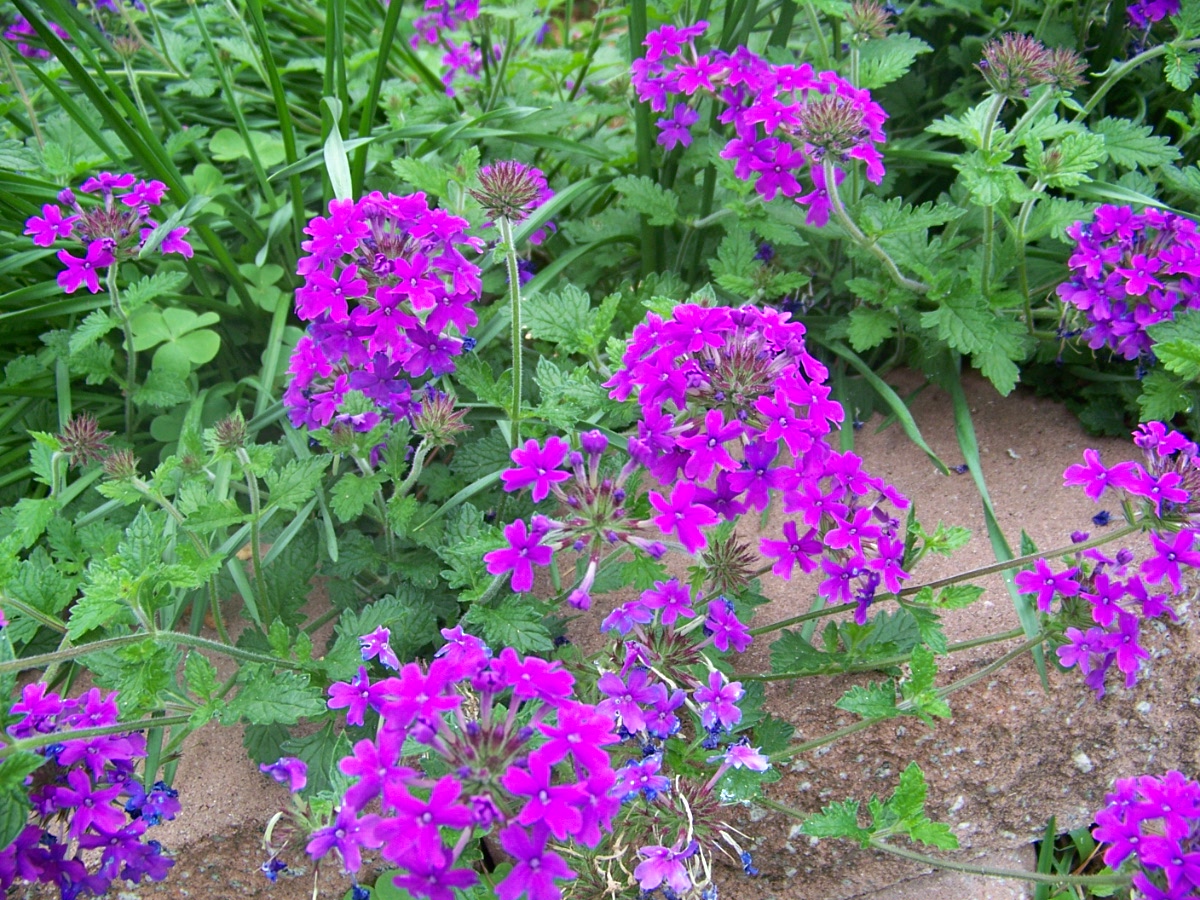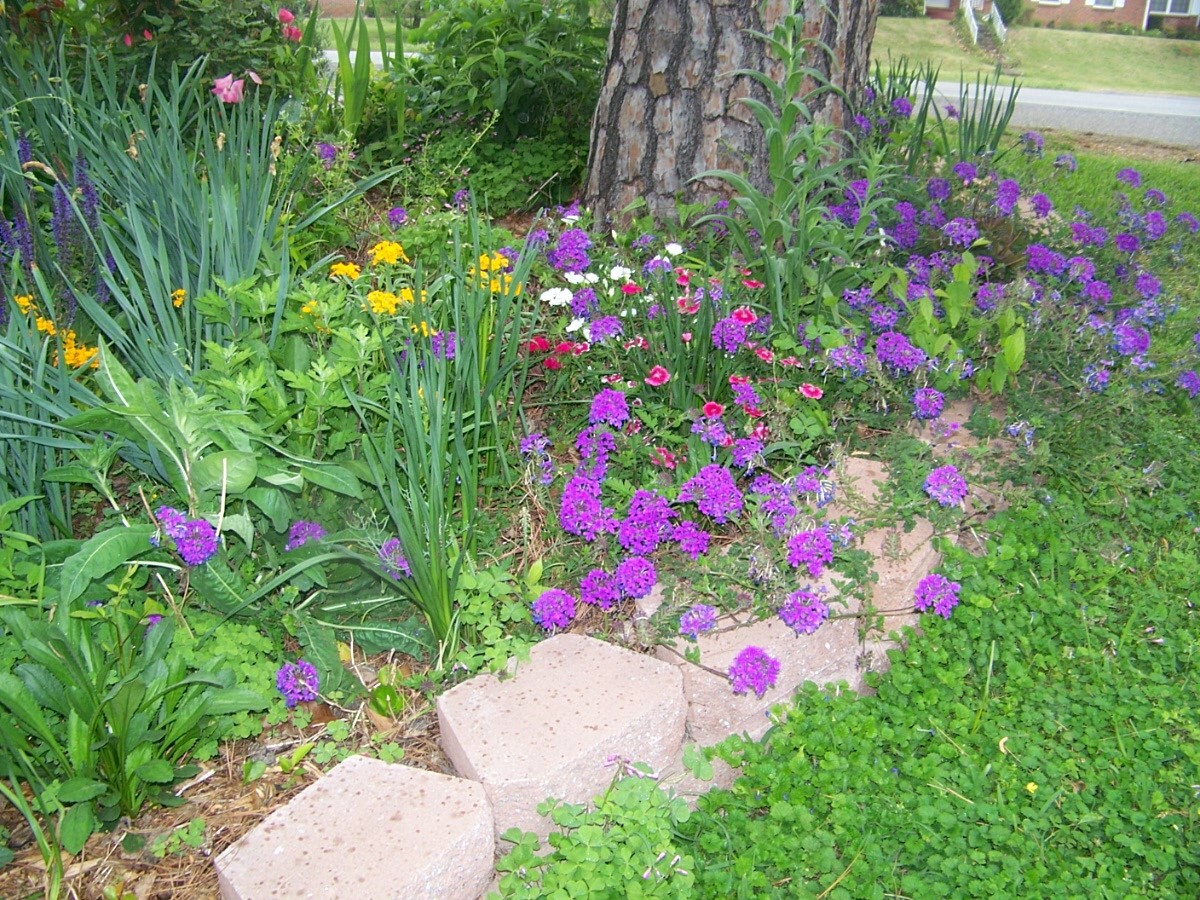|
Gardens Ablaze |
||
|
|
Verbena Behind every great man is a woman rolling her eyes - Jim Carrey |
DirectGardening.com |
|
Additional Perennial Profiles Site Map
Home
|
The uses for Verbena are almost unlimited. They are fantastic rock garden plants, border plants, ground covers, or fillers for empty spaces in the garden. They can be combined with taller bulbs or other perennials, or grouped alone, as long as their location is in a full or nearly full-sun location. The colors (purple, pink, white, red, and variations of these) are some of the best and brightest in the gardening world. Their creeping habit makes them awesome as they spill over the sides of pots, window boxes, or hanging containers. They are short-lived perennials and eventually will die out, but they are so easy to propagate by stem cuttings that you should never have to buy new plants once you have established what you want in the garden. As far as winter hardiness, they do fine with no particular attention in my Zone 7 garden, and with mulch they will probably survive colder climates, especially the Homestead Purple variety pictured above.
Do give this plant at least 6-10 hours of full sun a day. I have a few that do fine with just a little less than this but I think it is because the shade is dappled in that spot so they are still getting the minimum requirements. If you do not give these plants the sun they require, they will not bloom and they will probably get powdery mildew and look sickly if they don't die outright. Do give the plant a really well-drained soil. It doesn't have to be particularly rich or humusy, but it MUST be well-drained. Verbena will not tolerate even the suggestion of any standing water. I think my original success was due to just digging a hole in the thick mulch and throwing them in there. By doing this, I inadvertently guaranteed a well-drained site. So do whatever you must to ensure that the site drains water off immediately or these plants will fail miserably. Once established they don't need tons of water either, but mine have done fine with the fairly frequent watering the rest of its garden bed receives. Do throw some flowering plant slow-release fertilizer out there about once a month or so. These are heavily flowering plants that bloom for a very long time, so don't starve them to death! It only takes a minute and the difference in plant quality is remarkable if you just take the time to do this simple step - this basically goes for the whole garden during the height of the growing season anyway. The plants will take up the nutrients as needed. Just find any fertilizer that says it's for Flowers and Vegetables and you should be good to go. I get mine at the dollar store for about 2 bucks for a 4 pound box (6-10-10) and everything out there is doing well. As noted above, Verbena is susceptible to some problems, but again, if you give these plants what they need, problems will be minimal. Powdery mildew is the most common problem seen, and if your plant has powdery mildew, yank that puppy out of there and put it somewhere it wants to be. I'm always pushing the envelope with these plants and I have had to do this many times. The plant will transplant nicely with no apparent shock so don't hesitate to move an underperformer. Another problem that is not as common is spider mites. If you notice little webs with tiny specks or discolored leaves on your plants, try spraying with a hard spray of water and see what happens. If that doesn't work, try an insecticidal soap. Although I have never personally seen spider mites on my plants, if you do find them, do not delay in eradicating them because they will not go away on their own and they will do irreparable damage to that plant. One other very important thing to note is that Verbenas absolutely must be trimmed back a couple of times a season. After the first spring burst of energy, as the flowers start to fade, just trim them all away, getting about 1/4 of the top of any particular stem. I know this seems harsh, but if you do not take the time for this, the plant will never bloom again. It takes maybe 3 weeks for the plant to regenerate and start another show. It also never hurts to deadhead individual spent flowers on Verbena plants so anytime you feel the urge, just go out there and do a few snips to keep the plant healthy. Lastly, cuttings to multiply your stock of verbenas is easy. Just use sharp scissors or a knife to cut just below a node (small thickened place on the stem where leaves are growing). It's probably best to remove any flower heads when taking cuttings, but I have successfully rooted Verbena with the flower heads intact. Poke a hole in some good potting soil and stick the stem in. Water well and check every day until the plant has rooted. It's best to keep cuttings in a shady place until well-rooted or they will wilt. Even if they do wilt a bit, just keep that soil moist by watering every day if necessary, and they will perk back up within a day or two and start sending out a root system. Once big enough to handle easily, transplant to the garden or container.
Custom Search
|
|
|
Gardens Ablaze |
||
 I
have always admired the vivid bright colors of Verbena in the spring garden
shop, but until recently, I really didn't have much luck with this plant
at all. I bet more than a few of you have the same story. So
listen up people, because if you give this plant halfway what it wants,
it will become one of your favorite spring to fall blooming garden plants
and you wonder how you did without it all this time.
I
have always admired the vivid bright colors of Verbena in the spring garden
shop, but until recently, I really didn't have much luck with this plant
at all. I bet more than a few of you have the same story. So
listen up people, because if you give this plant halfway what it wants,
it will become one of your favorite spring to fall blooming garden plants
and you wonder how you did without it all this time.  So
here are the do's and don'ts for growing gorgeous drifts of Verbena in your
own garden for all-season color:
So
here are the do's and don'ts for growing gorgeous drifts of Verbena in your
own garden for all-season color: